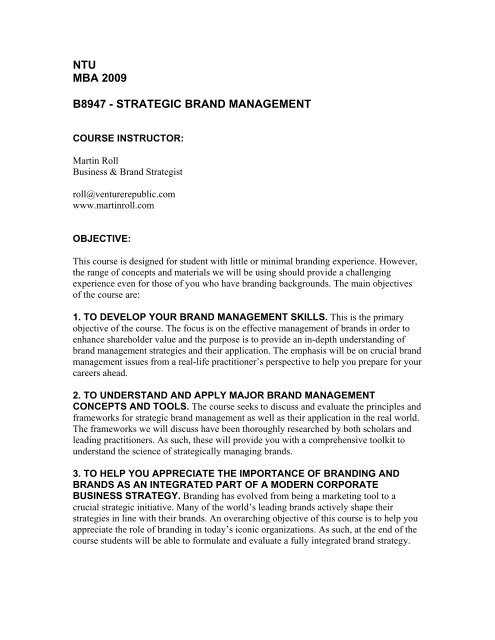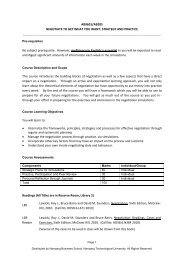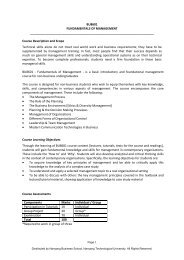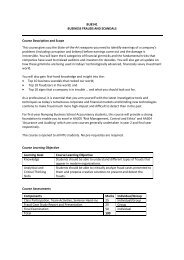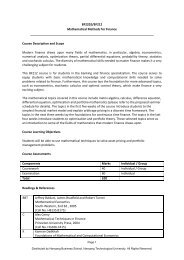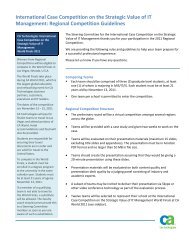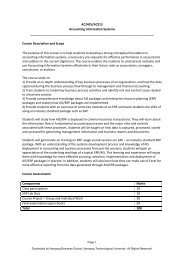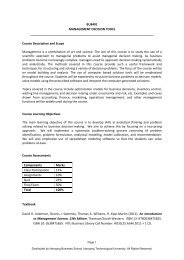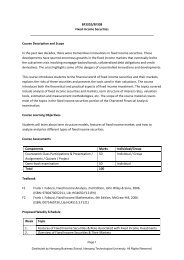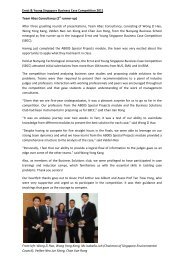ntu mba 2009 b8947 - strategic brand management - Nanyang ...
ntu mba 2009 b8947 - strategic brand management - Nanyang ...
ntu mba 2009 b8947 - strategic brand management - Nanyang ...
Create successful ePaper yourself
Turn your PDF publications into a flip-book with our unique Google optimized e-Paper software.
NTU<br />
MBA <strong>2009</strong><br />
B8947 - STRATEGIC BRAND MANAGEMENT<br />
COURSE INSTRUCTOR:<br />
Martin Roll<br />
Business & Brand Strategist<br />
roll@ve<strong>ntu</strong>rerepublic.com<br />
www.martinroll.com<br />
OBJECTIVE:<br />
This course is designed for student with little or minimal <strong>brand</strong>ing experience. However,<br />
the range of concepts and materials we will be using should provide a challenging<br />
experience even for those of you who have <strong>brand</strong>ing backgrounds. The main objectives<br />
of the course are:<br />
1. TO DEVELOP YOUR BRAND MANAGEMENT SKILLS. This is the primary<br />
objective of the course. The focus is on the effective <strong>management</strong> of <strong>brand</strong>s in order to<br />
enhance shareholder value and the purpose is to provide an in-depth understanding of<br />
<strong>brand</strong> <strong>management</strong> strategies and their application. The emphasis will be on crucial <strong>brand</strong><br />
<strong>management</strong> issues from a real-life practitioner’s perspective to help you prepare for your<br />
careers ahead.<br />
2. TO UNDERSTAND AND APPLY MAJOR BRAND MANAGEMENT<br />
CONCEPTS AND TOOLS. The course seeks to discuss and evaluate the principles and<br />
frameworks for <strong>strategic</strong> <strong>brand</strong> <strong>management</strong> as well as their application in the real world.<br />
The frameworks we will discuss have been thoroughly researched by both scholars and<br />
leading practitioners. As such, these will provide you with a comprehensive toolkit to<br />
understand the science of <strong>strategic</strong>ally managing <strong>brand</strong>s.<br />
3. TO HELP YOU APPRECIATE THE IMPORTANCE OF BRANDING AND<br />
BRANDS AS AN INTEGRATED PART OF A MODERN CORPORATE<br />
BUSINESS STRATEGY. Branding has evolved from being a marketing tool to a<br />
crucial <strong>strategic</strong> initiative. Many of the world’s leading <strong>brand</strong>s actively shape their<br />
strategies in line with their <strong>brand</strong>s. An overarching objective of this course is to help you<br />
appreciate the role of <strong>brand</strong>ing in today’s iconic organizations. As such, at the end of the<br />
course students will be able to formulate and evaluate a fully integrated <strong>brand</strong> strategy.
FORMAT:<br />
The course will consist of formal lectures, case analysis/ presentations and study group<br />
discussions.<br />
I am glad to work with students who are having difficulty with any aspect of the course.<br />
Please feel free to make an appointment to come and see me. I am accessible through<br />
email (roll@ve<strong>ntu</strong>rerepublic.com). Also, please feel free to send an email with any<br />
questions, needs or concerns you may have.<br />
This course is meant to be interactive, interesting, stimulating and fun!<br />
MAIN TEXTBOOKS<br />
Title: Asian Brand Strategy<br />
Author: Martin Roll<br />
Publisher: Palgrave Macmillan<br />
Edition: 2006<br />
ISBN: 1-4039-9279-7<br />
Title: Strategic Brand Management – Best Practice cases in <strong>brand</strong>ing (paperback)<br />
Author: Kevin Lane Keller<br />
Publisher: Prentice Hall<br />
Edition: 3. edition<br />
ISBN: 978-0-13-188865-4<br />
SUPPLEMENTARY BOOK<br />
This book is not mandatory for the course, but it is recommended for those who want<br />
more subject depth and academic stimulus.<br />
Title: Strategic Brand Management – Building, Measuring and Managing Brand Equity<br />
Author: Kevin Lane Keller<br />
Publisher: Prentice Hall<br />
Edition: Latest<br />
ISBN: 0-13-041150-7
REFERENCE BOOKS<br />
These books are meant for additional reading and insights but are not part of the course.<br />
They are a selection of my own favorite books. Keep them in your database for the future<br />
– they may inspire you during your career path.<br />
Title: Strategic Brand Management<br />
Author: Kevin Lane Keller<br />
Publisher: Prentice Hall<br />
Edition: 2003<br />
ISBN: 0-13-041150-7<br />
Title: Building strong <strong>brand</strong>s<br />
Author: David A. Aaker<br />
Publisher: Free Press<br />
Edition: 1996<br />
ISBN: 002900151X<br />
Title: Brand Leadership<br />
Author: David A. Aaker<br />
Publisher: Free Press<br />
Edition: 2000<br />
ISBN: 0-684-83924-5<br />
Title: Brand Portfolio Strategy<br />
Author: David A. Aaker<br />
Publisher: Free Press<br />
Edition: 2004<br />
ISBN: 0-7432-4938-0<br />
Title: Spanning Silos – The CMO<br />
Imperative<br />
Author: David A. Aaker<br />
Publisher: Harvard Business School<br />
Press<br />
Edition: 2008<br />
ISBN: 978-1-4221-2876-3<br />
Title: Brand Asset Management –<br />
Driving Profitable Growth<br />
through your <strong>brand</strong>s<br />
Author: Scott M. Davis<br />
Publisher: Jossey-Bass<br />
Edition: First edition 2002<br />
ISBN: 0-7879-6394-1<br />
Title: Asian Branding – A Great Way to<br />
Fly<br />
Author: Ian Batey<br />
Publisher: Prentice Hal<br />
Edition: 2002<br />
ISBN: 0-13-066466-9<br />
Title: Private Label Strategy<br />
Author: Nirmalya Kumar<br />
Publisher: Harvard Business School<br />
Press<br />
Edition: 2007<br />
ISBN: 978-1-4221-2876-3<br />
Title: Corporate Religion<br />
Author: Jesper Kunde<br />
Publisher: Financial Times/ Prentice<br />
Hall<br />
Edition: 2000<br />
ISBN: 0-273-64380-0<br />
Title: Consumer Behaviour in Asia<br />
Author: Hellmut Schütte with Deanna<br />
Ciarlante<br />
Publisher: Macmillan Business<br />
Edition: 1998<br />
ISBN: 0-333-73625-7
Title: Luxury Brand Management<br />
Author: Michel Chevalier and Gerald<br />
Mazzalovo<br />
Publisher: Wiley<br />
Edition: 2008<br />
ISBN: 978-0-470-823262<br />
Title: Luxury Fashion Branding<br />
Author: Uche Okonkwo<br />
Publisher: Palgrave<br />
Edition: 2007<br />
ISBN: 0-230-52167-3<br />
Title: How <strong>brand</strong>s become icons<br />
Author: Douglas Holt<br />
Publisher: Harvard Business School Press<br />
Edition: 2004<br />
ISBN: 978-1578517749<br />
COURSE ASSESSMENT & REQUIREMENTS<br />
Evaluation of participants overall grade will be based upon the following components<br />
Class participation: 20%<br />
Case presentation: 50%<br />
Personal assignment: 30%<br />
The class discussions provide you with the opportunity to share your ideas and analyses<br />
with other participants in class. The weight assigned to class participation reflects its<br />
critical importance to the learning of everyone.
CLASS 1: BRAND LEADERSHIP – A PERSPECTIVE<br />
Course introduction & team formation.<br />
This is the introductory class which outlines the key concepts and tools for <strong>brand</strong>ing, how<br />
it adds value to businesses and why it will become increasingly important for Asian<br />
businesses.<br />
The class will outline the 10 steps to build a <strong>brand</strong> and provide an overview of <strong>brand</strong><br />
strategy and <strong>management</strong>.<br />
Topics:<br />
• What is a <strong>brand</strong>? Definitions and perspectives<br />
• The key concepts and tools for <strong>brand</strong>ing<br />
• How <strong>brand</strong>s adds value to businesses<br />
• The rise of <strong>brand</strong>s – the new value driver for businesses<br />
• Overview of <strong>brand</strong> strategy and <strong>management</strong><br />
• Branding – the strongest value driver towards 2020<br />
• The 10 steps to build a <strong>brand</strong><br />
• The role of the CEO and the executive team<br />
Case/assignments:<br />
Best Practice cases in <strong>brand</strong>ing: Acce<strong>ntu</strong>re<br />
Readings:<br />
Asian Brand Strategy: Chapter 1, 2 & 9<br />
Harvard Business Review (HBR) (Oct 2003): The Hidden Dragons<br />
McKinsey: Can Chinese <strong>brand</strong>s make it abroad?<br />
Building customer-based <strong>brand</strong> equity, Kevin Lane Keller, Marketing Management<br />
Douglas Holt: Brands & Branding<br />
Suggested readings:<br />
Strategic Brand Management: Chapter 1
CLASS 2: BRAND AUDIT, BRAND EQUITY AND BRAND VALUATION<br />
The <strong>brand</strong> audit is the essential first step for companies in the <strong>brand</strong> building process. It is<br />
a comprehensive process that involves four major phases: company analysis, customer<br />
analysis, competitor analysis and stakeholder analysis. The purpose of the <strong>brand</strong> audit is<br />
to provide the <strong>management</strong> with an overall analysis of the <strong>brand</strong> from internal and<br />
external sources. The <strong>brand</strong> audit provides a structured framework and a firm foundation<br />
on which companies can define <strong>brand</strong> identities and strategize their future actions.<br />
The <strong>brand</strong> equity measure relates to how <strong>brand</strong>s are driving customer demand and also<br />
influencing long term loyalty.<br />
The financial measure is the net present value of expected future earnings which is a<br />
common concept in business and within the financial community.<br />
Topics:<br />
• The <strong>brand</strong> <strong>management</strong> model<br />
• The <strong>brand</strong> audit<br />
• Brand equity<br />
• Brand valuation<br />
• Brand metrics – methods and tools<br />
• Measure and improve the <strong>brand</strong> ROI<br />
Case/assignments:<br />
Best Practice cases in <strong>brand</strong>ing: Starbucks, American Express<br />
Readings:<br />
Asian Brand Strategy: Chapter 3, 7 & 8<br />
Brand Economics: Bringing new clarity to <strong>brand</strong> <strong>management</strong> & strategy<br />
McKinsey: Better, Faster & Cheaper<br />
Inter<strong>brand</strong>: Brand Valuation<br />
Suggested readings:<br />
Strategic Brand Management: Chapter 2, 8, 9 & 10
CLASS 3: BRAND IDENTITY, STRATEGY AND POSITIONING<br />
A <strong>brand</strong> identity describes the company’s <strong>strategic</strong> intention for the <strong>brand</strong>, its uniqueness,<br />
meaning and values, and basically how the <strong>brand</strong> aims at being positioned in the market<br />
place. It projects how the company wants the <strong>brand</strong> to be perceived by customers and<br />
other stakeholders. Brand identity is the <strong>strategic</strong> charter for the <strong>brand</strong> and links closely<br />
to the overall business strategy.<br />
The <strong>brand</strong> identity of a <strong>brand</strong> serves two main purposes. Internally, the identity guides all<br />
the <strong>strategic</strong> decisions regarding the <strong>brand</strong> like the communication decisions, the<br />
<strong>brand</strong>/line extension decisions, the <strong>brand</strong> architecture decisions, and the association and<br />
partnering decisions. Externally, it provides the customers with a clear sense of what the<br />
<strong>brand</strong> stands for, its essence, promises and personality – depending on how well the<br />
company expresses and delivers on the promises from the <strong>brand</strong> identity.<br />
Topics:<br />
• What is <strong>brand</strong> identity?<br />
• Developing the <strong>brand</strong> identity<br />
• Brand essence/ Brand personality<br />
• Attributes, benefits and values<br />
• Points-of parity & points-ofdifference<br />
• Brand positioning<br />
• The value curve and its<br />
implications<br />
• Brand architecture<br />
• Sub-<strong>brand</strong>s<br />
• Brand extensions & line<br />
extensions<br />
• Corporate <strong>brand</strong>s versus product<br />
<strong>brand</strong>s<br />
• Brand portfolio <strong>management</strong><br />
Case/assignments:<br />
Best Practice cases in <strong>brand</strong>ing: Dockers<br />
Readings:<br />
Asian Brand Strategy: Chapter 6<br />
McKinsey: Better Branding<br />
McKinsey: Repositioning <strong>brand</strong>s<br />
David Aaker: Leveraging the Corporate<br />
Brand<br />
Douglas Holt: What becomes an icon<br />
most?<br />
Kevin Keller: Importance of corporate<br />
<strong>brand</strong> personality<br />
Quelch: How do global <strong>brand</strong>s compete?<br />
Suggested readings:<br />
Strategic Brand Management: Chapter 3, 4, 5 & 11
CLASS 4: BRAND IMPLEMENTATION & MANAGEMENT<br />
The final step in building a <strong>brand</strong> is the <strong>brand</strong> implementation process. The previous class<br />
of <strong>brand</strong> research and <strong>brand</strong> identity will enable the company to establish the foundation<br />
of the <strong>brand</strong> and its intended direction.<br />
The <strong>brand</strong> implementation phase is where all the formulated strategies are put into<br />
practice in the market place. It brings the <strong>brand</strong> to life and this is where <strong>brand</strong><br />
associations ultimately start to form in the mindset of customers. Successful <strong>brand</strong>s align<br />
their touch points with all stakeholders, and the class will illustrate how this is done<br />
internally and externally.<br />
Marketing communications is the face of a <strong>brand</strong> strategy. The class will illustrate how a<br />
marketer translates a <strong>brand</strong> strategy into marketing communications and the steps needed<br />
to make it successful.<br />
Topics:<br />
• Brand programs<br />
• Marketing and <strong>brand</strong> tools<br />
• Local and global relevance – the<br />
balance<br />
• Local, regional and global<br />
<strong>management</strong><br />
• Country <strong>brand</strong>ing<br />
• Touch points<br />
• Employees as <strong>brand</strong> a<strong>mba</strong>ssadors<br />
• How <strong>brand</strong>ing can become an<br />
internal change agent<br />
• Organizational alignment<br />
• Build and sustain a <strong>brand</strong> culture<br />
• Balancing marketing trade-offs<br />
• Critical success factors for <strong>brand</strong><br />
leadership<br />
Case/assignments:<br />
Best Practice cases in <strong>brand</strong>ing: RedBull, Nike<br />
Readings:<br />
Asian Brand Strategy: Chapter 4 & 10<br />
McKinsey: The evolving role of the CMO<br />
Integrating <strong>brand</strong>ing strategy across markets: Building international <strong>brand</strong> architecture<br />
HBR: Creating the living <strong>brand</strong><br />
HBR: Kill a <strong>brand</strong>, keep the customer<br />
HBR: Selling the <strong>brand</strong> inside<br />
Suggested readings:<br />
Strategic Brand Management: Chapter 6, 13 & 14
Martin Roll<br />
Business & <strong>brand</strong> strategist<br />
Martin Roll is a world-renowned thought-leader on value creation through <strong>brand</strong> equity<br />
driven by tremendous global experience and insights. He facilitates business leaders and<br />
organizations to think bold for future strategies. By focusing on building and managing<br />
successful businesses through iconic <strong>brand</strong>s, Martin Roll helps boardrooms to enhance<br />
shareholder value and create sustainable competitive advantage.<br />
Martin Roll delivers the combined value of an experienced international business<br />
strategist and senior advisor to corporate boards and marketing executives of the world’s<br />
largest companies including many corporations in Asia. He is the founder and CEO of<br />
Ve<strong>ntu</strong>reRepublic, a <strong>strategic</strong> advisory firm, and brings more than 20 years of<br />
<strong>management</strong> experience. Martin Roll holds an MBA from INSEAD.<br />
Martin Roll is not only a highly accomplished speaker and presenter but as well a<br />
talented and well trained moderator of panel discussions and roundtables. He is a<br />
valuable contributor to any senior <strong>management</strong> discussion on the subject of leadership,<br />
innovation, growth, organizational excellence and <strong>brand</strong> equity, its close link to<br />
<strong>management</strong> and how it drives outstanding performance through shareholder value.<br />
He strides the industry-academia continuum and delivers superior value to his global<br />
audiences. Every year, he travels 500.000 miles on all continents and speaks at more than<br />
100 global top-level conferences and executive seminars. He is also a frequent guest<br />
lecturer at INSEAD and other leading global business schools.<br />
Martin Roll is the author of the global bestseller Asian Brand Strategy, a very<br />
compelling book of frameworks for Asian <strong>brand</strong>ing and the winning formula for any<br />
boardroom. Asian Brand Strategy was named “Best Business Books 2006” by<br />
Strategy+Business magazine.<br />
www.martinroll.com
Asian Brand Strategy<br />
Endorsements<br />
“Martin Roll's Asian Brand Strategy provides superb motivation and substance into Asian<br />
<strong>brand</strong>s and <strong>brand</strong>ing. It offers invaluable inspiration and guidance into one of the hottest<br />
areas of marketing.”<br />
Kevin Lane Keller, Professor of Marketing, Tuck School of Business<br />
“As Asian firms aspire to become global and challenge the competitive landscape<br />
dominated by Western firms, they recognize that cost and quality advantages are<br />
necessary but not sufficient for sustained value creation. Martin Roll provides an<br />
illuminating insight into a critical missing link - the importance of global <strong>brand</strong>s. Rich in<br />
concepts and detail this is an invaluable manifesto for Asian CEOs. A must read that will<br />
change perspectives and priorities.”<br />
C.K. Prahalad, Paul and Ruth McCracken Distinguished University Professor, The Ross<br />
School of Business, The University of Michigan<br />
“Growing presence of Asian companies in Western markets, high profile cross border<br />
M&A, and the spreading of Asian cultural and social trends have highlighted the<br />
potential impact of Asian <strong>brand</strong>s in the global markets. But <strong>brand</strong> building has<br />
historically not been a high priority for many Asian companies. Martin Roll makes a<br />
compelling argument for <strong>brand</strong>ing to be one of the top issues for Asian CEOs to enhance<br />
shareholder value. He provides a thoughtful set of approaches, and illustrates these nicely<br />
with interesting cases from the region.”<br />
Minsok Pak, Principal, McKinsey & Co.<br />
“An insightful look into <strong>brand</strong>ing as a <strong>strategic</strong> tool for Asian companies - Asian Brand<br />
Strategy by Martin Roll is a brilliant, incisive read. A treasure of ideas and case studies,<br />
this compelling new book discusses the challenges Asian corporations face to stay<br />
relevant in today's dynamic, global market.”<br />
N. R. Narayana Murthy, Chairman and Chief Mentor, Infosys Technologies Ltd.<br />
“Branding has become a hot topic for Asian companies which are no longer able to<br />
compete purely as contract manufacturers and now need to directly “own” the end<br />
consumer. As shelf space in bookstores get filled with myriad books on <strong>brand</strong>ing as the<br />
next best thing, Martin Roll’s book Asian Brand Strategy stands out above the pack. It<br />
has the serious theoretical framework which underpins any real understanding of the role
of <strong>brand</strong>ing in business. And it has the practical pointers which make it useful for anyone<br />
wanting to implement a <strong>brand</strong> strategy.<br />
Roll’s five major messages – that <strong>brand</strong>ing can enhance shareholder value; that it must be<br />
led by the top person in a company; that it is not simply slick advertising and PR but a<br />
holistic integration of many business functions; that Asian companies must embrace<br />
<strong>brand</strong>ing to move up the value chain, and that <strong>brand</strong>ing strategies can be measured<br />
through metrics – resonate strongly within my own company and have been the key<br />
factors for Banyan Tree’s own success in <strong>brand</strong>ing.<br />
I would strongly recommend this book as compulsory reading for anyone who wants to<br />
understand the power of <strong>brand</strong>ing and how to implement a practical, no-gimmicks <strong>brand</strong><br />
strategy.”<br />
Ho Kwon Ping, Executive Chairman, Banyan Tree Group<br />
"Martin Roll has provided a much-anticipated primer on how Asian companies approach<br />
the discipline of <strong>brand</strong>ing. With the focus of the world economy gravitating inexorably to<br />
the Asia Pacific region, Asian Brand Strategy provides timely insight into the key players<br />
of today and the global competitors of tomorrow".<br />
Alan Lammin, Publishing Director, Asia, TIME


